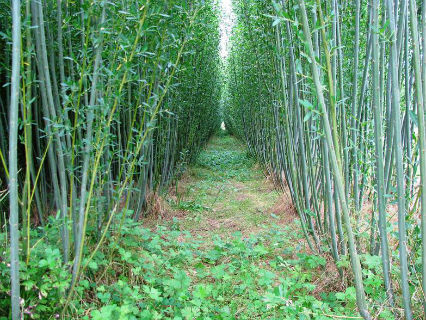
Farmers growing shrub willow for bioenergy are helped by a BCAP project in New York State that aims to make the biomass crop more financially viable.

Farmers growing shrub willow for bioenergy are helped by a BCAP project in New York State that aims to make the biomass crop more financially viable.
Residue management and tillage can reduce greenhouse gas emissions from soils during production of corn stover for biofuel.

Funded by AFRI. Learn More.

Crop residues such as corn stover are on track to make up a large part of our future renewable-energy supply. …

Grown for biofuel, energy-efficient shrub willow sequesters carbon below-ground, life-cycle assessment shows.
Shrub willow is a short-rotation woody biomass crop that could be an important part of our renewable energy future. By sequestering carbon in below-ground biomass, it can …
Genetic diversity in native switchgrass populations will benefit new varieties developed for biofuel production and ecosystem services.

Identification of gene pools and their geographic patterns will help in the development of new …
Learn about sustainability indicators used to gauge and evaluate a farm’s progress toward a more sustainable future.
|
|
|
Contour farming with buffer strips. These conservation practices reduce erosion and water pollution.. Photo: NRCS/USDA; Wikimedia Commons. |
The amount of carbon dioxide released from coal and wood depends on the type of coal or wood consumed and the moisture contents of both. A very rough estimate is that for each unit of coal or wood consumed, 1.5 units of CO2 are released. Higher-grade coal has higher carbon content so the amount of CO2 released per unit mass would also be higher.
The major difference between the carbon released from burning coal and wood is that …
 A thorough bioenergy curriculum for all audiences, created by over 40 university specialists.
A thorough bioenergy curriculum for all audiences, created by over 40 university specialists.This curriculum from the Bioenergy Training Center was created by over 40 university specialists in the U.S. North Central region to provide unbiased, researched and peer-reviewed information for this emerging field.
Targeted for Extension and other community educators, these resources also provide valuable information for farmers, landowners, community leaders, industry and the inquisitive public.
Online courses are offered as modules, where learners can choose to study sequentially …

Indirect land use change (iLUC) is a widely debated concept that seeks to quantify the impact a new policy or commercial activity has on global patterns of existing land use. These impacts differ …
Direct land use, or direct land use change, refers to land already used for a specific purpose (for example, growing food) and whose future use will achieve the same result. The term “direct land use change” might be used for a situation in which a field was being converted from corn-for-ethanol to switchgrass production, as in both cases the land would ultimately be used to grow crops for biofuel production. “Indirect land use” or “Indirect land use change”, on the …
 |
| Mixtures offer advantages over monocultures. Michael Bomford photo. |
Learn the benefits of planting diverse prairie grass mixtures for biofuel feedstocks.
The vast majority of farm-based bioenergy production currently relies on monocultures: pure stands of a single plant species such as corn or soybeans. Yet researchers have long known that plant mixtures or polycultures offer numerous advantages, including resistance to plant diseases, insect pests, weeds …